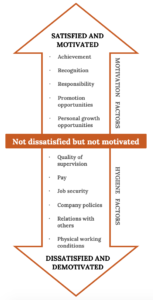9.3 Two Factor Theory
Adapted by Stephen Skripak with Ron Poff
Another psychologist, Frederick Herzberg, set out to determine which work factors (such as wages, job security, or advancement) made people feel good about their jobs and which factors made them feel bad about their jobs. He surveyed workers, analyzed the results, and concluded that to understand employee satisfaction (or dissatisfaction), he had to divide work factors into two categories:
. Those factors that are strong contributors to job satisfaction
. Those factors that are not strong contributors to satisfaction but that must be present to meet a worker’s expectations and prevent job dissatisfaction
Figure 9.2 illustrates Herzberg’s two-factor theory. Note that motivation factors (such as promotion opportunities) relate to the nature of the work itself and the way the employee performs it. Hygiene factors (such as physical working conditions) relate to the environment in which it’s performed.

Two-Factor Theory and the Workplace
We’ll ask the same question about Herzberg’s model as we did about Maslow’s: What does it mean for managers? Suppose you’re a senior manager in an accounting firm, where you supervise a team of accountants, each of whom has been with the firm for five years. How would you use Herzberg’s model to motivate the employees who report to you? Let’s start with hygiene factors. Are salaries reasonable? What about working conditions? Does each accountant have his or her own workspace, or are they crammed into tiny workrooms? Are they being properly supervised or are they left on their own to sink or swim? If hygiene factors like these don’t meet employees’ expectations, they may be dissatisfied with their jobs.
Fixing problems related to hygiene factors may alleviate job dissatisfaction, but it won’t necessarily improve anyone’s job satisfaction. To increase satisfaction (and motivate someone to perform better), you must address motivation factors. Is the work itself challenging and stimulating? Do employees receive recognition for jobs well done? Will the work that an accountant has been assigned help him or her to advance in the firm? According to Herzberg, motivation requires a twofold approach: eliminating “dissatisfiers” and enhancing satisfiers.
Key Takeaways
- Two-factor theory divides work factors into motivation factors (those that are strong contributors to job satisfaction) and hygiene factors (those that, though not big contributors to satisfaction, must be present to prevent job dissatisfaction).
Those factors that are strong contributors to job satisfaction
Those factors that are not strong contributors to satisfaction but that must be present to meet a worker’s expectations and prevent job dissatisfaction

